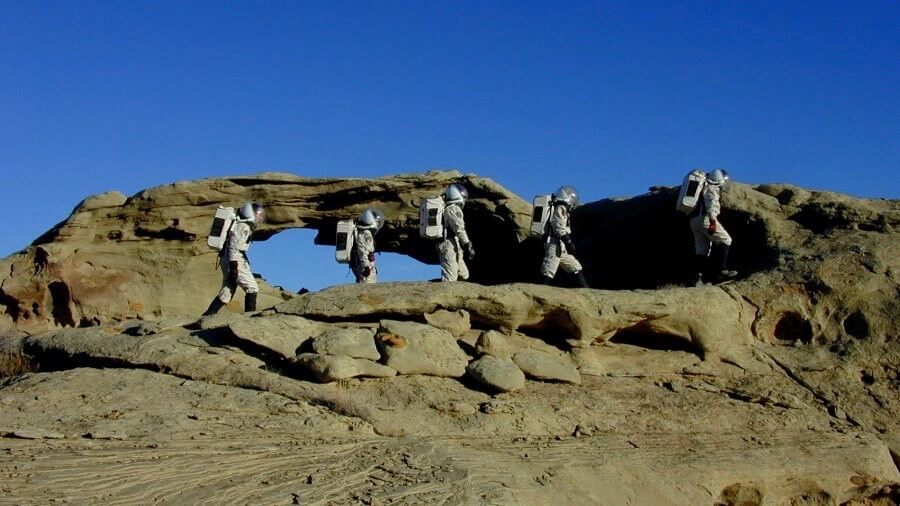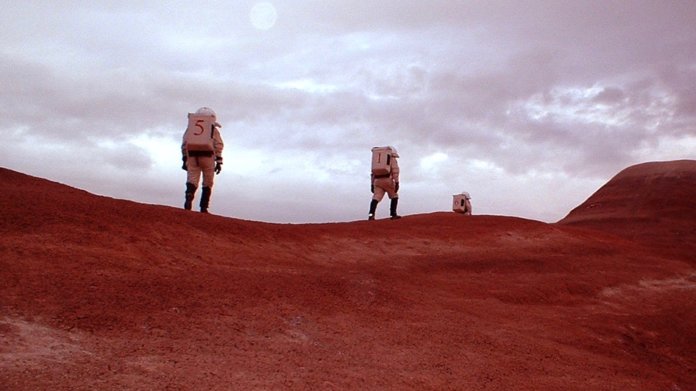I live in California’s Bay Area, so for the last week and a half I’ve joined around seven million people in a shelter-in-place mandate. While my family is adjusting to this new normal, I’ve been reminded of a previous time I made a massive adjustment: when I lived on Mars.
Thanks to the Mars Society, I took part in two Mars simulations in the southeastern Utah desert and one simulation in the Canadian high Arctic, only a few hundred miles from the North Pole. For each simulation I joined five men and women from around the world. We had to quickly get to know each other and relentlessly work together in an extreme and remote environment. Plus, we had to maintain the simulation—which meant that except for emergencies, no one could go outside without donning a mock spacesuit and passing through a dummy airlock.

Today I’m “sheltering” at home with my husband, son, and father. We can go outside for a very small number of reasons, such as exercising and grocery shopping. That’s it! Although we’ve known each other for years, we’re facing entirely new pressures in how we live, work, and learn together. Here’s what I learned from living on Mars, and how I think we can transform lessons from today’s Covid-19 crisis into a solid foundation for humanity’s future on Earth and off planet.
Privacy Matters
My immediate concern about sheltering in place? The mental-health effects of a loss of privacy. My home now has people in it all day, every day. Thanks to years spent working from home, I know that I need physical and mental space in regular doses.
During my Mars simulations, “home” was “The Hab,” a two-story metal can that rocked and groaned in a high wind. Downstairs were the “airlocks”, the toilet, and the engineering and laboratory spaces; upstairs were the kitchen, the common area, a storage loft—plus six individual bedrooms. In my windowless bedroom, which was so narrow I couldn’t stretch my arms out, I could close the door on my exhaustion, my homesickness, and the strain of interacting with a very, very small social group for a long and challenging period of time.
Privacy isn’t just about shutting other people out. It’s about dedicating space to being with yourself. Virginia Woolf famously said that to write (which to me means “to think”), you need money and a door with a lock on it. Today, my home office lacks a door or even a fourth wall. Even though my husband bought me some fancy noise-canceling headphones for Christmas, as a family we’re establishing norms to foster privacy, like wearing headphones by default and trading off child supervision so that at least one adult has some headspace.
The forging of new customs, rituals, and social norms around privacy will be crucial to future Mars colonists. Spaceships and early settlements may lack everyday sensory inputs, such as textures and scents, that support mental health; composting toilets and unwashed socks constantly remind you that you’re never really alone (although you’d be shocked by what you can get used to).
Could we use haptic tech and emerging digital olfactory technologies to build rich, private spaces? Would virtual reality have eased my yearning to feel the wind on my face when I was in sim? Today, those of us sheltering in place can still take a walk outside, but privacy at home remains a challenge—and no doubt, like our family, people are getting creative. The Covid-19 crisis may turn out to be the forcing function we need to answer these questions, and others.
Food Matters
We’ve all seen images of store shelves ransacked by panic-buying citizens. Interestingly, in my local stores, while toilet paper and hand sanitizer are in short supply, fruits and vegetables are easily available. With the lockdown my family is no longer eating out (although we can still order takeout)—and with three full meals at home every day, we’re doing a lot of dishes. But overall, our eating habits haven’t changed that much, since we already focus on whole, fresh foods.
For each Mars simulation, if we didn’t have it, we didn’t get it; there was no popping down to the store. Our Utah station eventually included a greenhouse, but when I was there, we had no fresh greens. We had no produce in the Arctic. When a visiting reporter tried to eat a banana that he had brought with him, he was assaulted by six piercing gazes. He silently handed over the fruit, and we meticulously divided it into six pieces. That was the best bite of banana I’ve ever tasted. I never understood Ernest Shackleton’s fixation on food until that day.
“Freshies,” as they call fresh produce today in Antarctica, clearly boost both physical and mental health in extreme environments. Freshies come with sounds, textures, and smells that can be intimately tied to normative, social memories. I remember that single bite of banana with fondness, but my stomach lurches as I recall my desperate attempts to eat canned meat (eventually I gave up, which is not a nutrition-forward choice). Food is central to our personal and social identities, as well as to our bodies.
When a reporter asked what would prevent me from joining a real Mars mission, I quickly responded, “If they don’t have cheese, I’m not going.” I wasn’t joking. Fortunately, a host of technologies, from 3D printing to indoor farming to cellular agriculture, may support the health and happiness of future space travelers and colonists. Until then, revolutions in the future of agriculture and sustainable living will be crucial for supporting humans on Earth, including in the face of climate change and during times of crisis. While you’re under lockdown, be sure to treat your body right: eat plenty of fresh fruits and vegetables, but skip the processed foods. Your immune system (and your microbiome!) will thank you.
People Matter
The phrase “social distancing” has exploded into our collective consciousness, but as the WHO has pointed out, our response to coronavirus needs to focus on “physical distancing.” Humans are social animals, including—perhaps especially—in times of crisis.
Our six-person simulation crews were international and slanted toward scientists and engineers; we first met at each simulation’s jumping-off point. We were supported by a team in Colorado, who we contacted via email with a 30-minute delay (in Utah) or once per day (in the Arctic). Our relationships with our crewmates and support team evolved as we connected around projects and interests. And yes, there was conflict, particularly as each simulation progressively impacted our health and made us more emotionally distant from our everyday lives.

To counteract those forces, we developed rituals, catchphrases, warning signals. When I had something important to say, I’d tap my left shoulder with my right hand—because that is how I activated my radio when I wore my spacesuit outside. When one of us was close to melting down, we’d head up to the storage loft, with its commanding view of a strange horizon. Coming down from the loft always meant hot chocolate (our cozy drink of choice for our daily haiku slams).
Technologies like video conferencing and virtual reality have the potential to establish new and meaningful rituals and interactions. For these touchpoints, we shouldn’t just be thinking about translating physical interactions into digital forms, but also about crafting new, human-centered meanings that are nonetheless designed to exploit the affordances of digital existence. If haiku and hot chocolate isn’t your thing, consider using a digital platform like Zoom to host board games, dance parties, happy hours—with the beverages of your choice, of course.
I think that supporting technologies will be important for closing not just gaps in space, but also gaps in time: a message from Earth takes as long as 22 minutes to reach Mars (hence our email delay in sim), and the reply needs the same time to come back. And that delay is just for the next planet over! Clever tech will be needed to bring us together across space and time.
Learning From Today to Design Tomorrow
Covid-19 is bringing us face-to-face with a host of uncertainties, pressures, and yes, catastrophes. But if we have the patience and courage to learn from this experience, we empower ourselves to build stronger, inclusive, and resilient futures on Earth and elsewhere.
Perhaps the most important thing I learned from my Mars simulations is the benefit of slowing down and disconnecting. On Mars, we each struggled to adapt to our new normal—and my simulations happened more than a decade ago, when people were far less dependent on connection. During each simulation, I pushed through that detox stage to a smaller, quieter world. A world where I had time to watch a flower bloom on my lab bench. Where I would sit every day with the only five people in my orbit, sip hot chocolate, and laugh at our bad haikus.
Sheltering in my home in California, I’m looking for positive touchpoints every day. While I’m anxious that my business is down, I’m finding gratitude for and ways to use the time that I’ve gained from my new commute-free, travel-free life. I see my neighbors more often now, although from a safe six feet away. My son helps to cook dinner most nights, since we’re not dashing in the door frantic with hunger. We’re developing new rituals and evolving old ones.
Am I nervous about the future? Yes. I’m also changing, and just like I came home from Mars a different person each time, I expect to be a different person when this immediate crisis passes.
I refuse to be consumed by Covid-19 and its fallout. Instead, I’m seeking ways to catalyze a better future. Hard-earned insights from today’s crisis have the potential to transform life here on Earth, as well as humanity’s next chapter. No matter where we go from here, we have this moment to define what matters to us, as individuals and as a species. As futurist Anne Lise Kjaer recently wrote, Covid-19 is forcing us to “build windmills and harness the winds of change.” Are you ready to build a windmill to power your future?
Image Credit: Tiffany Vora



